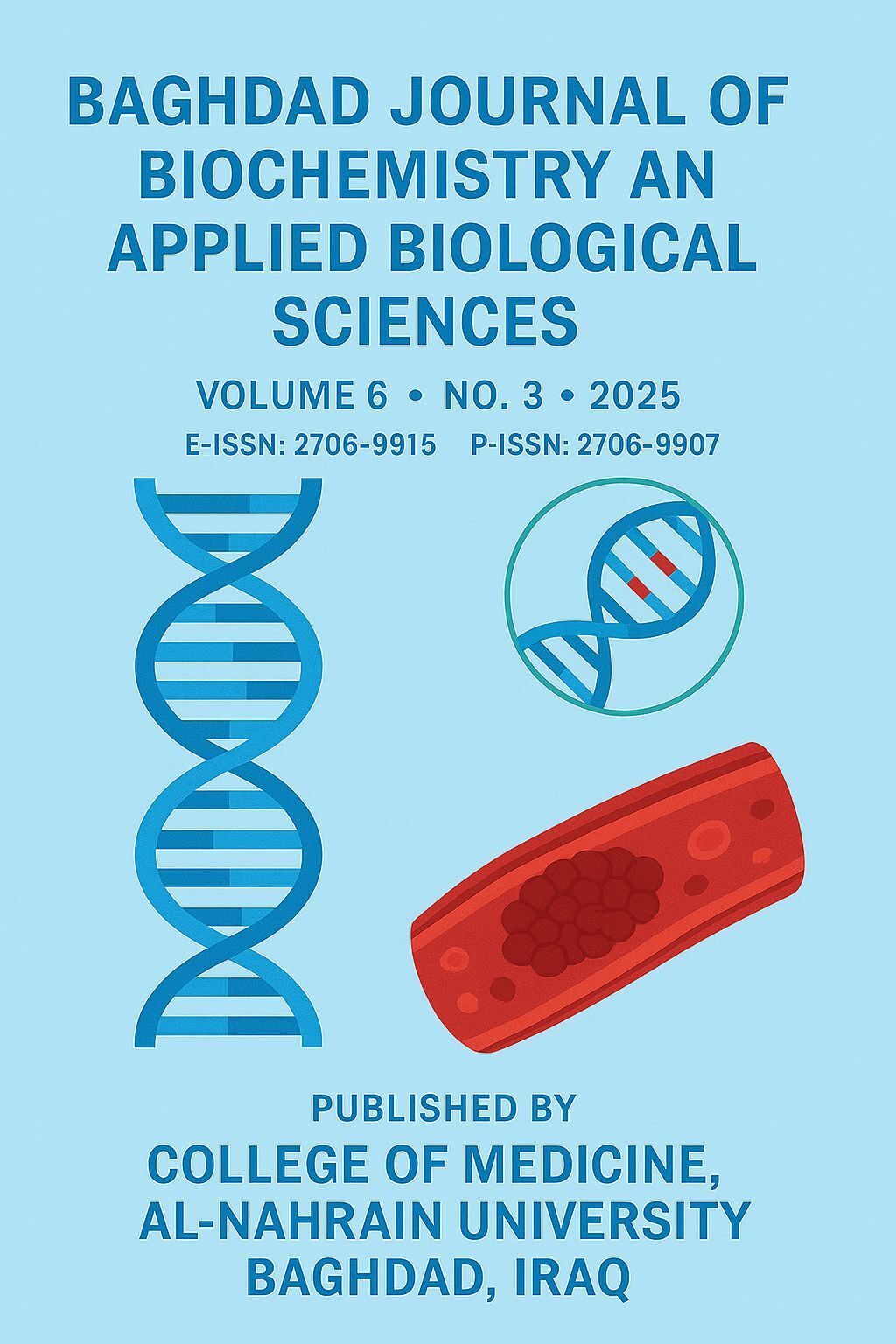The Role of 13-Hydroxyoctadecadienoic Acid, 15-Lipoxygenase, and Peroxisome Proliferator-Activated Receptor Alpha Gene Polymorphism (rs1800206) in Acute Coronary Syndrome: Pathophysiological Insights and Biomarker Relevance
DOI:
https://doi.org/10.47419/bjbabs.v6i03.401Keywords:
Acute Coronary Syndrome, Cardiac myosin-binding protein C , cMyBP-C, Myocardial Injury, Early Diagnosis, Cardiac specific proteins, 15-lipoxygenase, 15-LOXAbstract
Acute Coronary Syndrome (ACS) represents a spectrum of life-threatening cardiovascular conditions characterized by sudden myocardial ischemia. This review synthesizes current knowledge on the pathophysiological roles of 13-hydroxyoctadecadienoic acid (13-HODE), 15-lipoxygenase (15-LOX), and peroxisome proliferator-activated receptor alpha (PPAR-α) in ACS development, with particular emphasis on the PPAR-α rs1800206 (Leu162Val) polymorphism. Emerging evidence highlights the dual role of 13-HODE as both a pro-inflammatory mediator and angiogenic factor, while 15-LOX drives oxidative stress and contributes to plaque destabilization. The PPAR-α pathway emerges as a critical regulator of lipid metabolism and vascular inflammation, with the rs1800206 variant modifying disease susceptibility and therapeutic responses to fibrates. The authors further explore established and novel biomarkers, including high-sensitivity troponin, CK-MB, hs-CRP, and atherogenic lipid profiles, which collectively enhance ACS diagnosis and risk stratification. The integration of these molecular and genetic markers provides a framework for understanding the complex interplay between inflammation, oxidative stress, and metabolic dysregulation in ACS. Therefore, the findings have value in the clinic since they increase therapy choices for PPAR-α and draw attention to the potential for personalized medicine in ACS. This literature review endeavors to push precision medicine for ACS, by reviewing the specific mechanisms of 13-HODE, 15-LOX and PPAR-α polymorphisms and showing how this information can be applied to help patients.
Metrics
Downloads
References
Surya A. Machine Learning and Ensemble Approach Onto Predicting Heart Disease. arXiv preprint.https://doi.org/10.48550/arXiv:211108667. 2021.
Di Cesare M, Perel P, Taylor S, Kabudula C, Bixby H, Gaziano TA, et al. The heart of the world. Global heart. 2024;19(1):11. doi: 10.5334/gh.1288
Kobe MJ. Structural and Kinetic Investigations of 15-Lipoxygenase-2: Louisiana State University and Agricultural & Mechanical College; 2015. https://www.proquest.com/openview/a826604a327416abf2ef21e00ad7f138/1?pq-origsite=gscholar&cbl=18750&diss=y
Mitra S. Insights into 5-Lipoxygenase Active Site and Catalysis: Louisiana State University and Agricultural & Mechanical College; 2015. https://digitalcommons.lsu.edu/gradschool_dissertations/3000
Singh A, Museedi AS, Grossman SA. Acute coronary syndrome. 2017. PMID: 29083796
Kumar A, Cannon CP, editors. Acute coronary syndromes: diagnosis and management, part I. Mayo Clinic Proceedings; 2009: Elsevier. https://doi.org/10.4065/84.10.917
Erba F, Mei G, Minicozzi V, Sabatucci A, Di Venere A, Maccarrone M. Conformational dynamics of lipoxygenases and their interaction with biological membranes. International journal of molecular sciences. 2024;25(4):2241. https://doi.org/10.3390/ijms25042241
Snodgrass RG, Zezina E, Namgaladze D, Gupta S, Angioni C, Geisslinger G, et al. A novel function for 15-lipoxygenases in cholesterol homeostasis and CCL17 production in human macrophages. Frontiers in immunology. 2018;9:1906. https://doi.org/10.3389/fimmu.2018.01906
Manicone AM, McGuire JK. Matrix metalloproteinases as modulators of inflammation. Seminars in cell & developmental biology. 2008;19(1):3441.DOI.10.1016/j.semcdb.2007.07.003.
Umeno A, Sakashita M, Sugino S, Murotomi K, Okuzawa T, Morita N, et al. Comprehensive analysis of PPARγ agonist activities of stereo-, regio-, and enantio-isomers of hydroxyoctadecadienoic acids. Bioscience Reports. 2020;40(4): https://doi.org/10.1042/BSR20193767.
Yessoufou A, Wahli W. Multifaceted roles of peroxisome proliferator-activated receptors (PPARs) at the cellular and whole organism levels. Swiss Medical Weekly. 2010;140(3738):w13071.DOI.10.4414/smw.2010.13071.
Spindler SA, Sarkar FH, Sakr WA, Blackburn ML, Bull AW, Lagattuta M, et al. Production of 13-hydroxyoctadecadienoic acid (13-HODE) by prostate tumors and cell lines. Biochemical and biophysical research communications. 1997;239(3):775.https://doi.org/10.1006/bbrc.1997.7471
Cheng HS, Tan WR, Low ZS, Marvalim C, Lee JYH, Tan NS. Exploration and development of PPAR modulators in health and disease: an update of clinical evidence. International journal of molecular sciences. 2019;20(20): https://doi.org/10.3390/ijms20205055.
Wagner K-D, Wagner N. PPARs and myocardial infarction. International journal of molecular sciences. 2020; https://doi.org/10.3390/ijms21249436.
Pawlak M, Lefebvre P, Staels B. Molecular mechanism of PPARα action and its impact on lipid metabolism, inflammation and fibrosis in non-alcoholic fatty liver disease. Journal of hepatology. 2015;62(3):720-33. https://doi.org/10.1016/j.jhep.2014.10.039
Changizi Z, Kajbaf F, Moslehi A. An overview of the role of peroxisome proliferator-activated receptors in liver diseases. Journal of Clinical and Translational Hepatology. 2023;11(7):1542. doi: 10.14218/JCTH.2023.00334
Berger J, Moller DE. The mechanisms of action of PPARs. Annual review of medicine. 2002;53(1):409-35. https://doi.org/10.1146/annurev.med.53.082901.104018
Uthurralt J, Gordish-Dressman H, Bradbury M, Tesi-Rocha C, Devaney J, Harmon B, et al. PPARα L162V underlies variation in serum triglycerides and subcutaneous fat volume in young males. BMC medical genetics. 2007;8:1-11. https://doi.org/10.1186/1471-2350-8-55.
Blackett PR, Sanghera DK. Genetic determinants of cardiometabolic risk: a proposed model for phenotype association and interaction. Journal of clinical lipidology. 2013;7(1):65-81. https://doi.org/10.1016/j.jacl.2012.04.079
Chaulin AM. Biology of cardiac troponins: Emphasis on metabolism. Biology. 2022;11(3):429.https://doi.org/10.3390/biology11030429
Papadaki M, Marston SB. The importance of intrinsically disordered segments of cardiac troponin in modulating function by phosphorylation and disease-causing mutations. Frontiers in physiology. 2016;7:508. https://doi.org/10.3389/fphys.2016.00508
Banait T, Wanjari A, Danade V, Banait S, Jain J. Role of high-sensitivity C-reactive protein (Hs-CRP) in non-communicable diseases: a review. Cureus. 2022;14(10). DOI: 10.7759/cureus.30225
Mormone A, Tortorella G, Esposito F, Caturano A, Marrone A, Cozzolino D, et al. Advances in pharmacological approaches for managing hypercholesterolemia: a comprehensive overview of novel treatments. Biomedicines. 2024;12(2):432. https://doi.org/10.3390/biomedicines12020432
Linton MF, Yancey PG, Davies SS, Jerome WG, Linton EF, Song WL, et al. The role of lipids and lipoproteins in atherosclerosis. Endotext [Internet]. 2019. PMID: 26844337
Han L, Shen W-J, Bittner S, Kraemer FB, Azhar S. PPARs: regulators of metabolism and as therapeutic targets in cardiovascular disease. Part I: PPAR-α. Future cardiology. 2017;13(3):259-78. https://doi.org/10.2217/fca-2016-0059
Kersten S. Integrated physiology and systems biology of PPARα. Molecular metabolism. 2014;3(4):354-71. https://doi.org/10.1016/j.molmet.2014.02.002
Downloads
Published
Issue
Section
Categories
License
Copyright (c) 2025 Abdullah Abdulsattar Raeef, Hassan H. Al-Saeed, Sami Mekhlif Mishlish

This work is licensed under a Creative Commons Attribution 4.0 International License.
The authors retain all proprietary rights, including copyright, such as patent and trademark rights and rights to any process or procedure described in the article.









